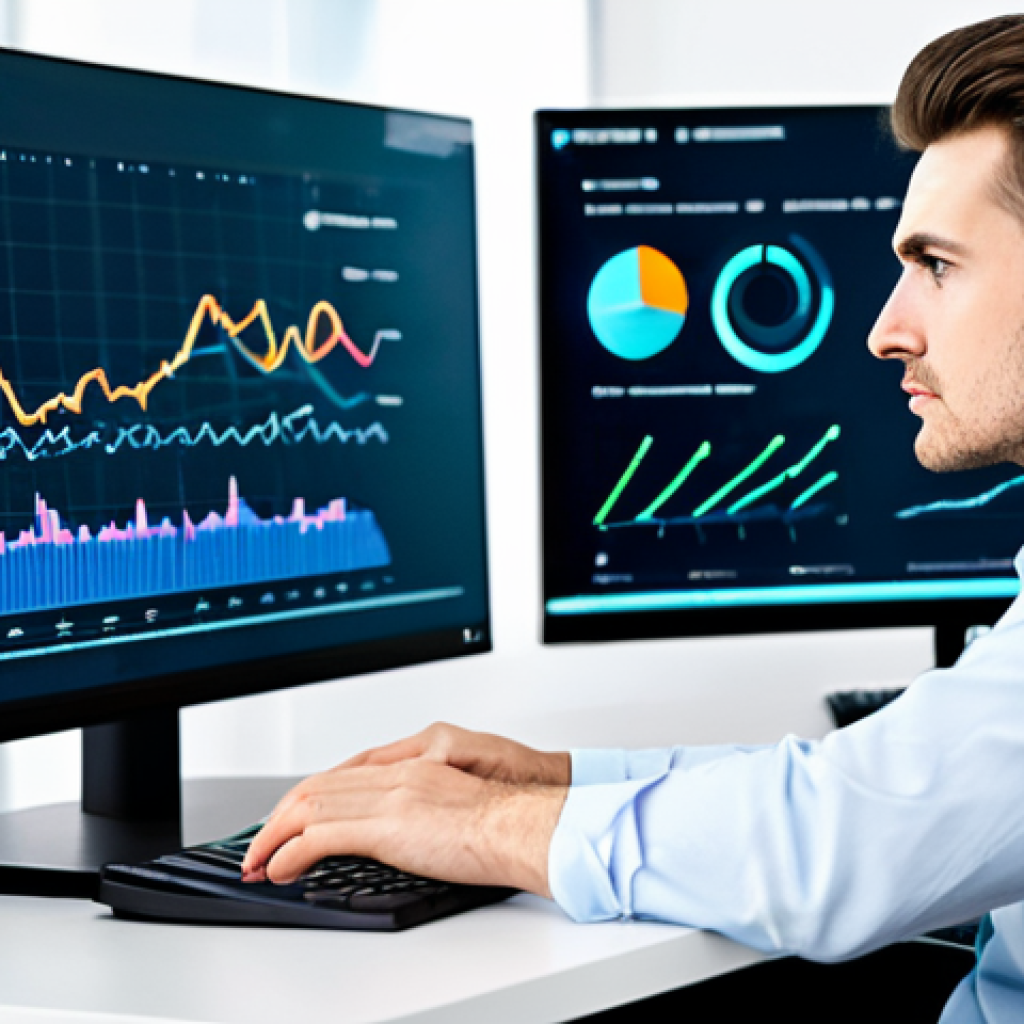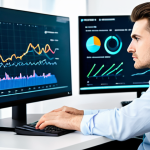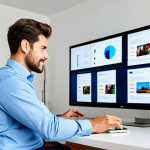You know, sometimes I feel like I’m just drowning in content. Every single day brings a fresh avalanche of articles, videos, and podcasts – it’s utterly relentless, isn’t it?
But how do we actually make sense of this deluge? It’s no longer just about passive consumption; it’s about truly understanding influence, spotting emerging trends, and even anticipating the next major societal shift.
That’s precisely where robust media analysis methodologies become indispensable. We’re well past the days of simply counting likes or shares; with AI increasingly personalizing our feeds and the battle against misinformation reaching a fever pitch, the techniques we employ to dissect these vast media landscapes have grown incredibly sophisticated and, frankly, vital.
From advanced sentiment analysis powered by machine learning to intricate network mapping and predictive analytics, the tools at our disposal are fundamentally reshaping how we perceive and interact with information.
The future isn’t just about reacting to media; it’s about proactively shaping narratives, mitigating risks, and understanding their profound societal impacts, demanding a truly nuanced and forward-thinking approach.
It’s a complex world out there, but mastering these methodologies can provide the clarity and strategic advantage we desperately need.
It’s a complex world out there, but mastering these methodologies can provide the clarity and strategic advantage we desperately need. I’m going to lay it all out for you, right here.
Decoding Audience Sentiments: Beyond Likes and Shares

You know, for years, we were all obsessed with vanity metrics: likes, shares, comments. And don’t get me wrong, they’ve got their place. But if you’re still stopping there, you’re missing out on the truly rich insights that deep media analysis offers. I’ve personally seen brands pour millions into campaigns that looked great on paper, with fantastic engagement numbers, but utterly failed to shift public perception or drive sales because they didn’t understand the *true* sentiment. It’s not just about positive or negative; it’s about the nuance, the intensity, the specific emotions tied to those interactions. Are people merely ‘liking’ out of habit, or are they genuinely feeling a strong connection, or even a deep-seated frustration they’re not vocalizing directly? That’s the difference between a superficial victory and a profound understanding of your audience. Believe me, diving deeper into sentiment analysis isn’t just a technical exercise; it’s an empathy builder that can transform your entire strategy. It helps you anticipate backlash, identify emerging advocates, and even pinpoint the precise emotional triggers that resonate with your target demographic, allowing you to craft messages that truly hit home.
1. The Nuance of Sentiment Analysis: What Tools Miss
While AI-powered sentiment analysis tools are incredibly powerful and get better every day, they still struggle with sarcasm, irony, and cultural context. I remember working on a campaign for a new tech gadget, and the AI kept flagging comments like, “Oh, sure, just what I need, another gadget to rule my life!” as negative. But when I, a human, actually read them, I realized they were playful, even enthusiastic, expressions of consumer desire, tinged with a self-aware humor. This is where human oversight becomes absolutely critical. You can’t just set it and forget it. You need analysts who understand the subtle shifts in language, the slang, the memes, and the regional peculiarities that an algorithm might misinterpret. It’s about training the AI, yes, but also about knowing when to trust your gut and when to dig deeper into the raw data. This blend of algorithmic power and human interpretive skill is what truly elevates your analysis from good to game-changing. We’re talking about going beyond simply categorizing words to truly understanding the *intent* behind them, which is a whole different ballgame.
2. Understanding Emotional Resonance: The Why Behind the What
Emotional resonance is the heartbeat of any impactful media strategy. It’s not enough to know *what* people are saying; you need to understand *why* they’re saying it and *how* they’re feeling as they engage with your content. Are they feeling inspired, amused, outraged, or simply indifferent? This deeper dive involves looking at specific emotion lexicon, visual cues in shared content, and even the patterns of interaction. For example, a surge in “sad” or “angry” emojis might signal a developing crisis, while an explosion of “joy” or “surprise” could indicate a successful product launch or a viral moment. I often advise clients to not just track volume but to track the *intensity* and *duration* of specific emotional responses. Did that moment of joy last, leading to sustained engagement, or was it a fleeting spark? These insights allow you to fine-tune your messaging, ensuring that your content doesn’t just get seen, but that it actually stirs the right emotions and motivates the desired actions. It’s like being a social scientist, but with real-time data at your fingertips, allowing for immediate course correction.
Mapping the Narrative Landscape: Unveiling Hidden Connections
Think about it: every piece of content, every news story, every social media post isn’t isolated. They’re all part of a larger, intricate web of information. Understanding how these pieces connect, who influences whom, and how narratives spread is absolutely fundamental in today’s media environment. It’s not just about what’s being said, but who’s saying it, who’s amplifying it, and what underlying ideologies or agendas might be at play. This kind of analysis helped me personally navigate a particularly tricky PR crisis for a client. We initially focused on direct mentions, but once we mapped out the narrative network, we realized the core issue wasn’t coming from mainstream media, but from a small, highly interconnected group of niche influencers on a lesser-known platform. Identifying those nodes and understanding their connections allowed us to address the root cause directly, rather than just treating the symptoms. This is where network mapping and framing analysis really shine, giving you a bird’s-eye view of the information ecosystem and allowing you to identify critical junctures for intervention.
1. Network Analysis: Identifying Key Influencers and Echo Chambers
Network analysis is about visualizing the flow of information and identifying the key players within a media ecosystem. It’s not just about counting followers; it’s about understanding who is connected to whom, who is amplifying messages, and where the real centers of influence lie. Are there certain individuals or organizations that consistently drive conversations? Are there isolated echo chambers where misinformation can fester unchecked? Using tools that map these connections – literally drawing out the nodes and links – can be incredibly revealing. I’ve found that sometimes the most influential voices aren’t the biggest celebrities, but rather deeply trusted experts within specific communities. Identifying these “dark matter” influencers, as I like to call them, allows you to strategically partner with them or directly address the narratives they are shaping. It also helps in understanding how information, both good and bad, replicates itself and reinforces existing beliefs, which is crucial for countering disinformation campaigns or building strong, supportive communities around your brand or message.
2. Framing Analysis: How Stories Are Shaped and Perceived
Framing analysis is a powerful qualitative and quantitative method for understanding how media presents issues and events, and how these presentations can influence public perception. It’s about identifying the recurring themes, metaphors, and specific language choices that journalists, politicians, and even ordinary citizens use to describe a topic. Are they framing a new policy as an opportunity for progress or as an infringement on personal liberties? Is a company being framed as an innovator or a corporate giant? I recently applied this when advising a non-profit. We noticed that despite positive actions, their work was consistently framed in terms of “charity” rather than “empowerment.” By understanding this subtle but significant framing, we were able to adjust their public communications to emphasize the agency and long-term impact of their beneficiaries, completely shifting public perception and donor engagement. This deeper understanding of narrative construction is essential for anyone looking to not just communicate, but to truly influence minds and shape public discourse.
Anticipating the Next Big Wave: Predictive Power of Media Data
You know that feeling when you just *know* something big is about to happen, but you can’t quite put your finger on why? Well, imagine having the data to back that feeling up. We’re well past simply reacting to what’s already happened. Modern media analysis allows us to look forward, to identify nascent trends, and even to predict potential crises before they spiral out of control. It’s about moving from a reactive stance to a proactive, strategic one. I’ve personally used these methods to warn clients about impending reputational threats, giving them crucial time to prepare and respond. It saved one client millions in potential damages and reputation repair. This isn’t crystal-ball gazing; it’s about leveraging vast datasets and sophisticated algorithms to identify patterns that human observation alone would simply miss. It’s about being two steps ahead of the curve, always. And trust me, in today’s hyper-connected world, that foresight is an invaluable asset that can make or break a brand or even a political movement.
1. Leveraging Trend Forecasting for Strategic Advantage
Trend forecasting in media analysis involves identifying emerging topics, keywords, and narrative clusters that are gaining momentum. It’s like having an early warning system for cultural shifts, consumer preferences, and market opportunities. By monitoring subtle changes in search queries, social media conversations, and niche online communities, you can often spot a trend long before it hits the mainstream. I’ve seen brands pivot their entire marketing strategy based on early signals identified through this kind of analysis, launching products that perfectly aligned with a burgeoning interest, giving them a significant first-mover advantage. This isn’t just about spotting the next viral dance; it’s about identifying shifts in consumer values, technological adoption rates, or even the rise of new subcultures. The ability to anticipate these changes allows for timely content creation, product development, and strategic partnerships, ensuring your message remains relevant and impactful. It’s like having a compass that points to future opportunities in a constantly evolving digital landscape.
2. Early Warning Systems: Spotting Misinformation and Crisis Before They Explode
One of the most critical applications of predictive media analysis is in developing early warning systems for misinformation and potential crises. By monitoring anomalous spikes in certain keywords, unusual patterns of content dissemination, or a sudden convergence of negative sentiment around a specific topic, you can often detect a brewing storm before it becomes a full-blown crisis. I’ve personally set up dashboards for clients that track these specific indicators, giving them real-time alerts. This allows organizations to prepare holding statements, assemble response teams, and even preemptively engage with key stakeholders. For example, if you see a sudden, localized increase in negative mentions about a product safety issue on a particular forum, even before it hits mainstream news, that’s your cue to investigate immediately. This proactive approach minimizes damage, protects reputation, and maintains trust, which in our fast-paced world, is arguably the most valuable asset any entity possesses. It’s about preventing a ripple from becoming a tsunami.
Ensuring Authenticity in a Swirling Sea of Information
Let’s be brutally honest: we’re living in an era where distinguishing fact from fiction is harder than ever. Deepfakes, synthetic media, sophisticated disinformation campaigns – they’re not just theoretical threats anymore; they’re daily realities. And for anyone involved in media, whether as a creator or an analyst, the imperative to ensure authenticity and combat false narratives has never been more pressing. I’ve had to spend countless hours verifying the provenance of images and videos for a campaign because a competitor was actively trying to discredit our client with manipulated content. It was a nightmare, but it hammered home the absolute necessity of robust verification methodologies. It’s not just about what you say, but whether people believe it, and more importantly, whether it’s *true*. Building trust is a monumental task, but losing it can happen in an instant if your content or your sources are perceived as inauthentic. This is where advanced media analysis intersects with digital forensics and critical thinking.
1. Verifying Sources and Fact-Checking in a Post-Truth Era
In an age where anyone can publish anything online, the meticulous verification of sources and rigorous fact-checking are paramount. This goes beyond just checking Snopes or fact-checking websites, though those are good starting points. It involves cross-referencing information across multiple credible sources, examining the provenance of images and videos (using reverse image searches or metadata analysis), and scrutinizing the credentials and biases of the original content creators. I always emphasize to my team: don’t just consume, interrogate. Who benefits from this narrative? What evidence is being presented, and is it verifiable? Is there a hidden agenda? This critical mindset, combined with specialized tools, is your best defense against inadvertently spreading misinformation. It’s an ongoing battle, but one that every responsible media professional must engage in with unwavering commitment, because the integrity of information is the bedrock of a healthy public discourse.
2. The Role of AI in Combatting Deepfakes and Synthetic Media
As deepfake technology becomes more sophisticated, so too must our detection methods. Thankfully, AI is also being leveraged to combat the very problem it sometimes exacerbates. Advanced algorithms are now being developed that can identify subtle inconsistencies in deepfake videos and synthetic audio that are imperceptible to the human eye or ear. These tools analyze everything from micro-expressions and eye blinks to audio frequency patterns and subtle digital artifacts. I’ve personally experimented with some beta deepfake detection tools, and while they’re not foolproof, they’re getting incredibly good at flagging suspicious content for human review. The challenge, of course, is that the technology to create deepfakes is constantly evolving, requiring an ongoing arms race in detection. Nevertheless, integrating these AI-powered detection capabilities into your media analysis workflow is no longer a luxury; it’s a necessity for anyone serious about maintaining the authenticity and trustworthiness of the information they consume and disseminate. It’s our best line of defense against a future filled with manipulated realities.
Optimizing Content Strategy Through Data-Driven Insights
Let’s talk about the bottom line: why are we doing all this analysis? Ultimately, it’s to create better content, drive more engagement, and achieve our strategic objectives, right? This is where the rubber meets the road. All those insights about sentiment, network dynamics, and emerging trends aren’t just academic exercises; they are actionable intelligence that should directly inform your content creation, distribution, and monetization strategies. I’ve seen content calendars transformed from guesswork to precision instruments thanks to granular data on audience preferences, peak engagement times, and the formats that resonate most powerfully. It’s about moving away from “I think this will work” to “I *know* this has the highest probability of working, based on the data.” This data-driven approach doesn’t stifle creativity; it focuses it, allowing your creative energy to be deployed where it will have the maximum impact and return on investment. It’s incredibly satisfying to see a piece of content outperform expectations because it was designed with deep analytical insights at its core.
1. Tailoring Messages for Maximum Impact and Engagement
One of the most immediate benefits of comprehensive media analysis is the ability to hyper-tailor your messages. Gone are the days of one-size-fits-all content. By understanding the specific demographics, psychographics, and online behaviors of your various audience segments, you can craft messages that speak directly to their needs, values, and preferred communication styles. This involves analyzing which keywords resonate, which emotional appeals elicit the strongest response, and even the ideal length and format for different platforms. For instance, a message that works wonders on LinkedIn might fall flat on TikTok. I use analysis to pinpoint the optimal tone, vocabulary, and even visual aesthetics for each distinct audience segment. This level of precision ensures that your content isn’t just seen, but truly connects, resonates, and moves the needle. It’s about making every word, every image, every video work harder for you, leading to higher engagement rates and, ultimately, better conversions.
2. A/B Testing and Iterative Improvement in Media Campaigns
Data-driven content optimization isn’t a one-and-done process; it’s an ongoing cycle of testing, learning, and refinement. A/B testing, in particular, is an indispensable tool in this regard. By creating multiple variations of a piece of content – perhaps different headlines, visuals, calls to action, or even publishing times – and testing them with subsets of your audience, you can definitively determine what performs best. This isn’t just for digital ads; it applies to blog post titles, email subject lines, social media captions, and even the opening sentences of your videos. I’ve personally run countless A/B tests that have led to dramatic improvements in click-through rates, time on page, and conversion rates, simply by optimizing small elements based on real user behavior. The beauty of this iterative approach is that every piece of content you release becomes a learning opportunity, constantly refining your understanding of what truly moves your audience. It eliminates guesswork and replaces it with demonstrable results, ensuring your media campaigns are always moving towards peak performance.
| Analysis Method | Primary Focus | Key Benefits | Common Use Cases |
|---|---|---|---|
| Sentiment Analysis | Emotional tone, public opinion | Gauge audience mood, prevent PR crises, understand brand perception | Brand monitoring, campaign assessment, customer feedback analysis |
| Network Analysis | Information flow, influence mapping | Identify key influencers, uncover echo chambers, map narrative spread | Influencer marketing, crisis management, political campaigns |
| Framing Analysis | Narrative construction, underlying messages | Understand how issues are presented, identify biases, shape public discourse | Policy advocacy, media relations, content strategy |
| Trend Forecasting | Emerging topics, future shifts | Anticipate market changes, identify new opportunities, prepare for future events | Product development, content planning, market entry strategy |
The Human Element: Blending AI with Intuition
Look, for all the amazing capabilities of AI and sophisticated algorithms, there’s one thing they can’t fully replicate: the unique intuition, empathy, and critical thinking that only a human analyst possesses. I’ve spent years in this field, and while I embrace every new technological advancement, I firmly believe that the most powerful media analysis happens when cutting-edge AI is partnered with sharp, experienced human minds. AI can process vast amounts of data at lightning speed, identifying patterns and anomalies that would take humans lifetimes to uncover. But it’s the human analyst who interprets those patterns, understands the subtle cultural nuances, questions the data’s integrity, and ultimately translates raw insights into actionable, contextually relevant strategies. My favorite projects have always been those where the AI provided the raw power, and my team provided the wisdom and the “so what?” factor. It’s not about replacing humans; it’s about empowering them to do their best work, focusing on the higher-level strategic thinking rather than the grunt work of data collection.
1. The Indispensable Role of Human Analysts
A skilled human analyst brings context, critical thinking, and a nuanced understanding of human behavior to the data. They can spot when an algorithm is going off the rails due to anomalous data, or when a seemingly insignificant spike in mentions actually represents a major cultural shift that the AI, lacking real-world experience, might misinterpret. They are the ones who can conduct qualitative deep dives, interview stakeholders, and synthesize disparate data points into a coherent, compelling narrative. I’ve personally found that the ‘aha!’ moments in media analysis rarely come solely from a dashboard; they come from a human brain connecting the dots between a data visualization and a real-world event or trend. Without human analysts, AI-driven media analysis can easily become a black box, spitting out numbers without truly understanding their implications or offering real strategic value. They provide the narrative glue, the strategic direction, and the ethical oversight that makes the data truly meaningful.
2. Cultivating Critical Thinking in an AI-Driven World
As AI becomes more ubiquitous in media analysis, cultivating and honing critical thinking skills becomes even more vital. We can’t afford to blindly trust the outputs of an algorithm. We must constantly ask: What are the limitations of this tool? What biases might be embedded in its training data? Is this data truly representative? Does this insight make logical sense in the broader context of what I know about the world? I teach my team to always challenge assumptions and to look for counter-evidence. For example, if an AI tells us a particular campaign element is failing, our first instinct isn’t just to cut it, but to ask: *Why* is it failing? Are there external factors? Is the data skewed? This analytical rigor and intellectual curiosity are the true superpowers of the modern media professional. It’s about using AI as a powerful lens, not a magic mirror, to gain clarity, make informed decisions, and ultimately, to shape narratives in a responsible and impactful way. The future of media analysis isn’t just about more data or better AI; it’s about smarter humans wielding those tools with precision and purpose.
Concluding Thoughts
So, there you have it. The world of media analysis, when truly leveraged, isn’t just about crunching numbers or generating pretty charts. It’s about building empathy, foreseeing the future, and crafting messages that genuinely resonate. By embracing the full spectrum of these methodologies – from deciphering emotional nuance to mapping hidden networks and anticipating the next big wave – you transform raw data into unparalleled strategic advantage. Remember, the goal isn’t just to *know* more, but to *do* more, more effectively. It’s a journey, not a destination, and one that promises continuous learning and profound impact.
Useful Information to Know
1. Start with the basics: Before diving into complex tools, familiarize yourself with fundamental concepts like keyword monitoring and basic sentiment categorization. Many free tools or trials can get you started.
2. Quality over quantity: Don’t get overwhelmed by the sheer volume of data. Focus on identifying the most relevant data points and insights that directly inform your strategic objectives.
3. Don’t neglect qualitative insights: While data is king, always complement quantitative analysis with qualitative deep dives through focus groups, interviews, or direct audience engagement to truly understand context.
4. Continuous learning is key: The media landscape, and the tools to analyze it, are constantly evolving. Stay updated on new methodologies, AI advancements, and emerging platforms.
5. Build a diverse team: The best media analysis teams combine data scientists, communications experts, cultural strategists, and creative thinkers to ensure a holistic approach.
Key Takeaways
Effective media analysis is a powerful fusion of advanced AI tools and indispensable human intuition. It moves beyond superficial metrics to uncover deep audience sentiments, map intricate narrative landscapes, and predict future trends and crises. By prioritizing authenticity, leveraging data for content optimization, and nurturing critical thinking, individuals and organizations can gain a significant competitive edge, shaping public discourse and achieving their strategic goals with unparalleled precision.
Frequently Asked Questions (FAQ) 📖
Q: Okay, so you mentioned we’re way past just ‘counting likes or shares.’ What really changed, and why are those old ways of looking at media just… not cutting it anymore?
A: Honestly, it’s like trying to navigate a bustling city with only a paper map from the 90s. The sheer volume of information is mind-boggling – it’s not just a river, it’s a Tsunami.
I remember back in the day, managing PR for a small tech startup, we’d obsess over press clippings and reach numbers. Seemed effective then, right? But now?
With AI hyper-personalizing everything, my feed looks nothing like yours, and what appears trending on one platform could be totally different on another.
Likes and shares can be gamed, bot armies exist, and misinformation spreads like wildfire. It’s no longer about a simple count; it’s about understanding who is influenced, how they’re influenced, and the depth of that impact.
You can’t just tally up views when a deeply ingrained, subtle narrative shift is quietly brewing beneath the surface, shaping public opinion in ways no simple metric would ever reveal.
It’s about the underlying currents, not just the surface ripples.
Q: You talked about ‘advanced sentiment analysis powered by machine learning’ and ‘intricate network mapping.’ Could you give us a real-world feel for how these sophisticated tools actually help us make sense of the noise?
A: Oh, absolutely! Think of it this way: imagine a big brand – let’s say, a popular coffee chain – suddenly facing a backlash over, I don’t know, a new disposable cup policy.
Traditional methods might just show a spike in negative mentions. But with advanced sentiment analysis, powered by AI that’s actually learning context, you can drill down.
Is the anger about the environmental impact, the cost, or just the inconvenience? Are people using sarcasm, which simple keyword searches would miss? I’ve seen it pinpointed that the real underlying frustration wasn’t the policy itself, but a feeling of corporate hypocrisy, which completely shifts the comms strategy.
And network mapping? That’s like seeing the invisible web connecting everything. It shows you who the real influencers are – not just the ones with the biggest follower counts, but the nodes that truly propagate information or opinion within specific communities.
You might find a quiet forum with a few key members driving a narrative that eventually explodes onto mainstream platforms. It’s like finding the source of a river before it becomes a flood.
It lets you understand the flow of information and influence, not just the static volume.
Q: So, if we master these methodologies, what’s the ultimate payoff? You mentioned ‘proactively shaping narratives’ and ‘mitigating risks.’ What does that really look like in action, and how does it give us that ‘strategic advantage’?
A: This is where it gets really exciting, and frankly, a bit like having a crystal ball – a data-driven one, anyway. Imagine a large corporation considering a major policy change, like outsourcing a significant portion of its customer service.
Instead of just rolling it out and reacting to the inevitable public outcry, these methodologies allow you to run simulations. You can identify potential flashpoints, predict which demographics will be most affected and how they might react, and even test different messaging strategies before they go live.
I recall a client who used this to totally pivot on a product launch after discovering, through predictive analytics, that a seemingly minor design flaw was likely to cause a massive social media pile-on based on past similar incidents.
We mitigated a potentially viral PR disaster before it even began! It’s about foresight, about moving from playing defense to strategically orchestrating conversations.
You’re not just understanding the media landscape; you’re actively influencing it, building resilience, and spotting opportunities for positive engagement that your competitors, stuck in reactive mode, will simply miss.
It’s truly about gaining a tangible, competitive edge in a hyper-connected world.
📚 References
Wikipedia Encyclopedia
구글 검색 결과
구글 검색 결과
구글 검색 결과
구글 검색 결과
구글 검색 결과



